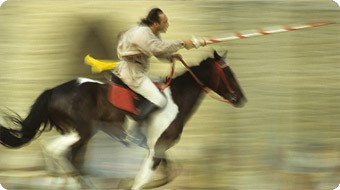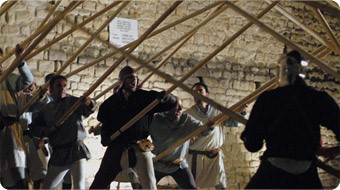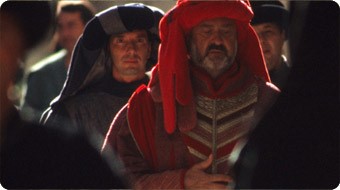Historical re-enactments
Palio of San Ginesio

In the ancient acts we always speak of the feast of St.. Roman Ginesio, under whose custody the new castle had been placed.
In the year 1171 the feast of the protector S. Ginesio Roman mime, it was celebrated by the Sanginesino people, in fact in that year the canons of the Collegiate Giberto, Attone, Burgarello, Guy, and Morico Picarelli receive an obligation from Pietro Barongello for a fee to be answered on the day of the feast of St.. Ginesio.
In the year 1221 the parish priest Guidone received an incense fee for the feast of S. Ginesio to be paid every year by Companione di Attone.
The festival was celebrated sumptuously at the expense of the Sanginesina Municipality, according to a ritual established by use and a protocol confirmed by the Statute of 1582.
On 25 August was a solemn day for the people and for lay and ecclesiastical institutions. The Podestà dressed in masterful clothes, the Priors with all familiars; the Massari of the Ripe and Morico castles intervened in a solemn form; the neighboring communities sent trumpeters. All, together with the captain of the fair, intervened at solemn vespers, and the day following the solemn mass, offering the pallium and a candle to the collegiate church. Every person of any class and condition wore the best clothes; and the Town Hall itself, after the solemn mass, he prepared a lavish banquet, where the captain of the fair sat, the Defenders and the foreign Trumpeters appointed by the respective Municipalities to honor the feast.
The feast of St.. Ginesio was preceded by four days of the fair and followed by another four by concession and munificence of Card. Andrea of Perugia with bull 15 October 1386.
The General Council elected the Captain of the fair 15 days before the party. One of the primary citizens of San Gimignano was always designated to this position, within the number of those eligible for the General Council.
The Captain was to reside in the defense palace. On the day of the feast and on the eight days of the fair he had the supreme command; it was up to him to decide on any dispute in general of trade. He was always accompanied by thirty soldiers, he always had to stay in the Palazzo dei Priori without ever returning to his home. He could make laws, promulgate manifestos, dictate orders.
The Captain chose his vicar, who always had to go on horseback to the fair accompanied and escorted by the army of Ripe and Morico; and this was to quell discord, the fights, protect contracts. Upon entering office, the Captain of the fair had to swear and promise before the Priors and Chancellor, holding his hand over the Gospels, to observe the laws of the Statute, to govern the Sanginesini in peace, to pronounce the causes according to merit and conscience, to use any regard for anyone in such a delicate task.
The Priors or Defenders also had to gather the General Council to provide for the feast of the Martyr St.. Ginesio, and had to provide that the colleges of lawyers, of the Notaries, Prosecutors, Shopkeepers and all those who practiced an art in Sanginesio offered a gift with the sign of the College to which they belonged, in honor of the Protector to the Collegiate Church. In case of non-compliance the penalties sanctioned by the Statute had to be applied.
The feast of San Ginesio was foreseen and regulated by the municipal statutes. The scholar Anna Maria Corbo, in the monograph San Ginesio and Macerata's musical tradition between the end of the 14th century and the beginning of the 16th century: giullari, players and musical instruments (San Ginesio 1992), analyzing «documents transcribed from the registers of Entrance and exit of chamberlain of the Community and ... preserved in the Historical Archive of the Municipality of San Ginesio "offers a selection of annotations by "Expense made on the Feast Genesij» from the 1369 to 1511 "To better follow the changes both in relation to the instruments and the origin of the players". The first expense document says: 1369 July August <"Also given and solves (the chamberlain) tubatoribus, ciaramellis, who came to the feast of the Holy Genesij Sonatori other, and Tamborini,... in the form of the statutes of said land ... ".
TODAY
The Palio di San Ginesio is disputed and assigned by 1970. At the beginning the two dexterity tournaments took place together on August 15th. Subsequently the event was divided into the eight days in which, traditionally, the Feast of San Ginesio unfolded at the “Campo del Palio” of Porta Picena:
the first, the Carousel of the Ring takes place on 13 August, at night
The second one, on Palio della Pacca takes place on the day of 15 August
The carousel of the Ring
The carousel of the ring is a test of great skill. The knights of the four Contrade compete trying to first hit and then remove with a spear a series of three rings suspended precariously from a pole. The number of assaults and the speed of the rider count. The most skilled and the fastest wins. The joust is followed by an audience cheering for their champion and trying to deconcentrate the opposing knights with screams and means that are not always correct. The rider who has collected the most rings in the shortest time and with the cleanest course is the winner of the Palio.
During the competition the Municipality assists from the field, mentre le dame, the girls and the extras participate in the cheering from the upper loggia of the Hospital of the Pilgrims. The various assaults are punctuated by the increasingly frenetic roll of the drums and the high-pitched sound of the trumpets.
The second one, on Palio della Pacca
Four horsemen, each representing the four Contrade of San Ginesio, Alvaneto, Ascarana, Offune and Picena, contend for the PACCA (that is the porchetta) in a tournament that consists in hitting the SARACENO's shield (that is, the silhouette of a knight) in the course of assaults carried out at great speed and following a tortuous path.
The pat, it is the trophy of the winning Contrada and is consumed during the celebrations of the Contrada.
The contrada with the score between the Giostra dell'Anello and the Palio della Pacca wins the "Palio of San Ginesio".
The winner, at the head of the historical procession and the fans of his Contrada, he goes towards the central square where he will be given the Palio. After a lap of honor to collect the applause, the procession returns to the Town Hall and the popular festival begins.
That of the feast of 15 August is a complex celebration that begins in the morning and ends in the evening. They participate in it as well 200 appearing in late medieval costumes, faithfully reconstructed in the fabrics, in dyeing and styling.
The Town Hall Parade which starts in the morning from the Town Hall, it is opened by trumpets and drums. Portagonfalone and Gonfaloniere follow in order, the four Priors of the Contrade, the Notary of Crimes, the Lawyer, the Doctor and the Attorney of the Municipality. They come after the Captain of the Fair, the Podestà, Chancellor, the Notary of the Monte di Pietà, the surgeon, the School Teacher, the Dativario, the Massaro. The four commanders close the procession, the man from the Pawnshop, the Weigher, the four keepers of the Doors, the Baiulo, the Bomber and the Armigeri.
The procession winds its way along the square and goes to the Collegiate Church to attend the Holy Mass. The officiating priest blesses the palio. The palio was originally a cut of cloth. Nowadays it is a banner, usually painted by a Ginesino artist. It will be assigned to the Contrada that will win the Palio di San Ginesio.
The Battle between Ginesini and Fermani

"The ages appeared in public writings to the memory of their losses."
(It was reported in official history so that the memory of it was handed down from father to son).
From the manuscripts of Francesco Majolini (cc. 130 – 131) and Paolo Ciampaglia (c. 189r.), both translation of the manuscript history genesin by Marinangelo Severini (L. VII, cc. 194v. – 195r.).
today
The re-enactment takes place on the evening of 31 July, at Porta Picena, or Porta Nuova.
This is the iconic event, which celebrates the municipal virtue par excellence of San Ginesio, and refers to an episode of the war between Ginesini and Fermani, occurred on the night of 30 November 1377 and immortalized by the will of the Municipality in the famous painting of the same name.
The re-enactment is particularly suggestive as a faithful late-medieval setting is recreated in the Borgo, inside the Porta Picena, and the armed men on both sides are dressed like the characters in the picture.
In this context, before the battle, shops are set up, inns and even a brothel; the ancient tanning trades are re-proposed, of the weaver, of the dyer and the forger. With the participation of singers and jugglers, young maidens ring graceful carols, in short, it is reproduced, as far as possible, a serene moment in the life of the Municipality.
But suddenly the spell breaks under the treacherous, unexpected attack by the Fermani.
Indeed, a mob of men-at-arms and soldiers of fortune is treacherously attacking the Ginesini.
Only a small baker notices the danger and warns that the enemies have entered the city. The alarm saves the community.
The battle is bloody, but in the end the Ginesini win. They defeat, they flee and chase enemies and cause many deaths in the field, so much so that from that moment the place was called Pian del Sangue.
Return of the exiles

For this sedition they had exile around 300; and their assets were given to the tax authorities, thus leaving the native soil, guided by Fortune, they arrived in Siena where they went to the City Guard for several months and had faithfully served it with such modesty, that the attention of those citizens is drawn.
Now one day asked by them Senesi de’ older, if from what place they drew their origin and why they had lived in that Presidium for such a long time, they replied that all were Genesini for the partiality bandits of the Fatherland with no hope of returning there again.
And in counting this they showed such great affliction, that there was no lack of those who would console them, and whoever exhibited his work to them pro '; wherefore they had such compassion for their miseries that in the Publico they had ambassadors elected to send them to Sanginesio, to negotiate peace, and compose their own things, which with the consent of the aforementioned Bandits who were weeping for joy brought themselves to our land and could do so much, and they oprorono with their authority and with the faculty of saying that the shop was totally put back in their will without any discrepancy.
And with such joyful tidings they return to Siena from’ Bandits, all of whom together with the same Ambassadors had their boundless joy and left for the homeland, carrying with him a wooden cross with the image of the Crucifix, which still today is revered with great devotion in the Pieve.
And upon this, once they reached the longed-for paternal soil, they all swore perpetually to preserve it, Christian ceremonies being celebrated with great and equal jubilation in the main church, and the Ambassadors gave our Municipality many laws, and Statutes of their Cities belonging to the Papal State, and to live well ".
From the translation by Francesco Ciampaglia (1581 c.) of the manuscript Historiae Genesinae by Marinangelo Severini (second half of the 16th century) in the annotations to the Ciampaglia by Telesforo Benigni, cc. 374, 378, manuscript sec. XVIII, at the Municipal Library.
TODAY
The reenactment of the Return of the Exiles takes place every three years in one of the two central weeks of June
This is the oldest re-enactment of San Ginesio. The historical representation takes place from afar 1963 and is associated with the triennial religious celebrations of the Crucifix of which we have news from 1730.
In 1730, indeed, San Ginesio was shaken by a very strong earthquake which surprised the population in the church of the Clerics (S. Maria in Vepretis) while he was in veneration of the ancient Sienese Crucifix, carried in procession to that church.
Contrary to what happened throughout the brand, in San Ginesio there was no damage. The credit was attributed to the miraculous Crucifix and it was decided that every three years, within a week, should visit all the major churches of San Ginesio.
The Crucifix had been brought by the Exiles who were returning from Siena after having obtained the pardon of the Ginesini. Accompanied by Sienese ambassadors, they entered from Porta Picena and were welcomed with open arms by the ancient adversaries. The Exiles also brought with them the Sienese Statutes, on which the Ginesini promised to exemplify their new Statute.
All this happened between the 1450 and the 1460. The historical re-enactment repeats all these events, suggestively mixing the sacred side with the profane side.

